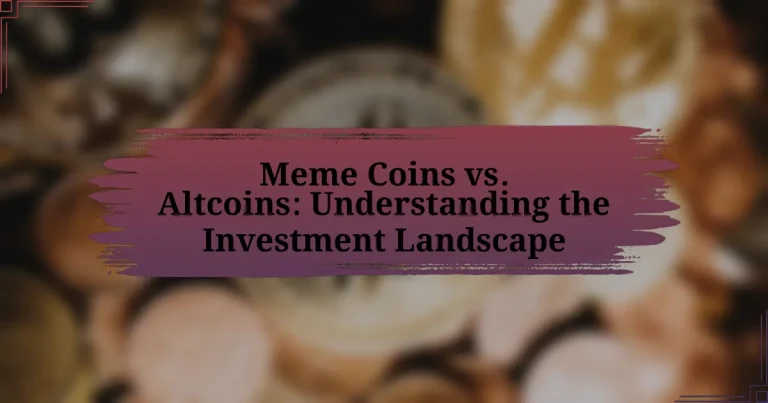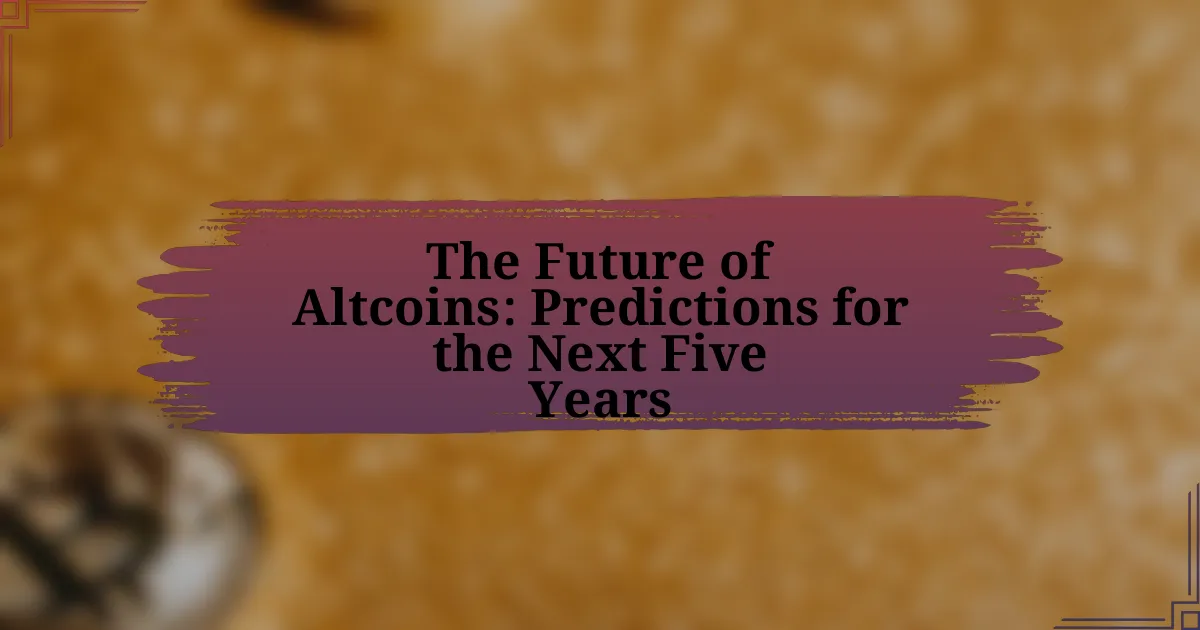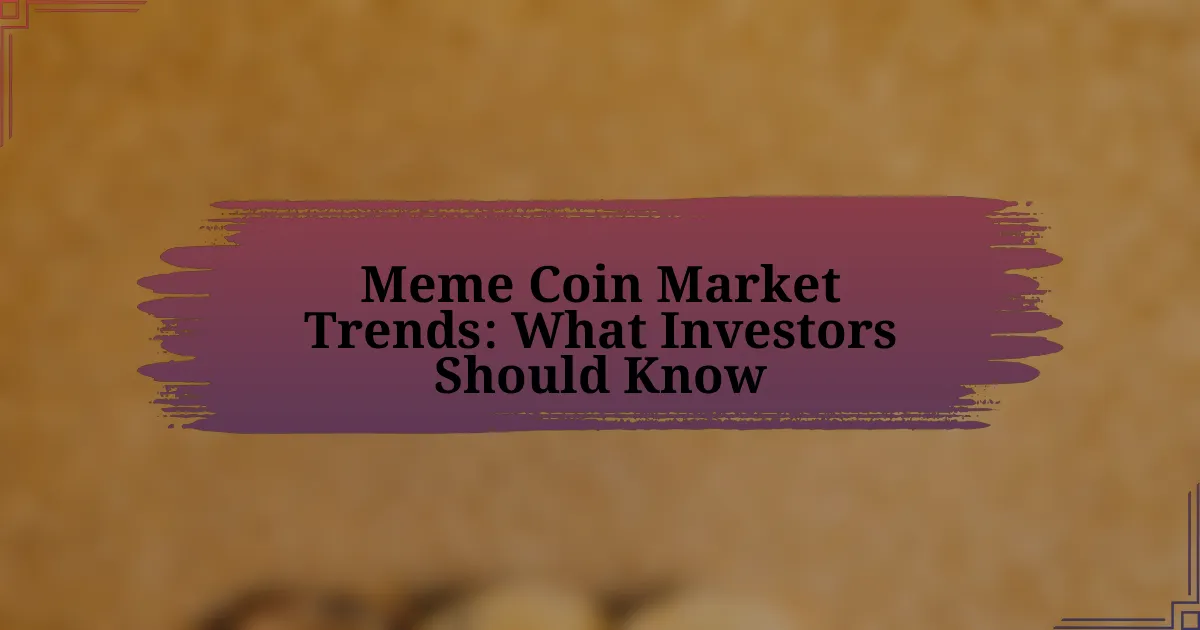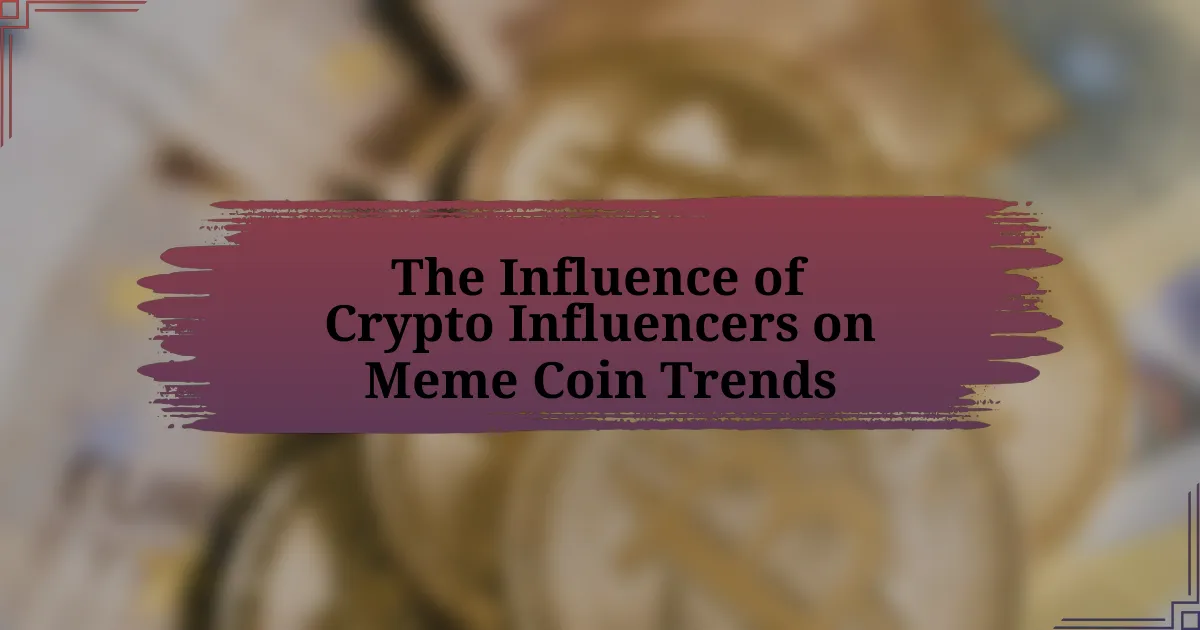Meme coins and altcoins represent two distinct categories within the cryptocurrency market. Meme coins, such as Dogecoin and Shiba Inu, primarily gain traction through social media and community engagement, often lacking fundamental utility. In contrast, altcoins encompass a broader range of cryptocurrencies that serve various functions and technologies, including stablecoins and utility tokens. The article explores the characteristics, risks, and rewards associated with investing in both meme coins and altcoins, highlighting the influence of social media, community dynamics, and market trends on their value. Additionally, it provides practical tips for investors to navigate this volatile landscape effectively.
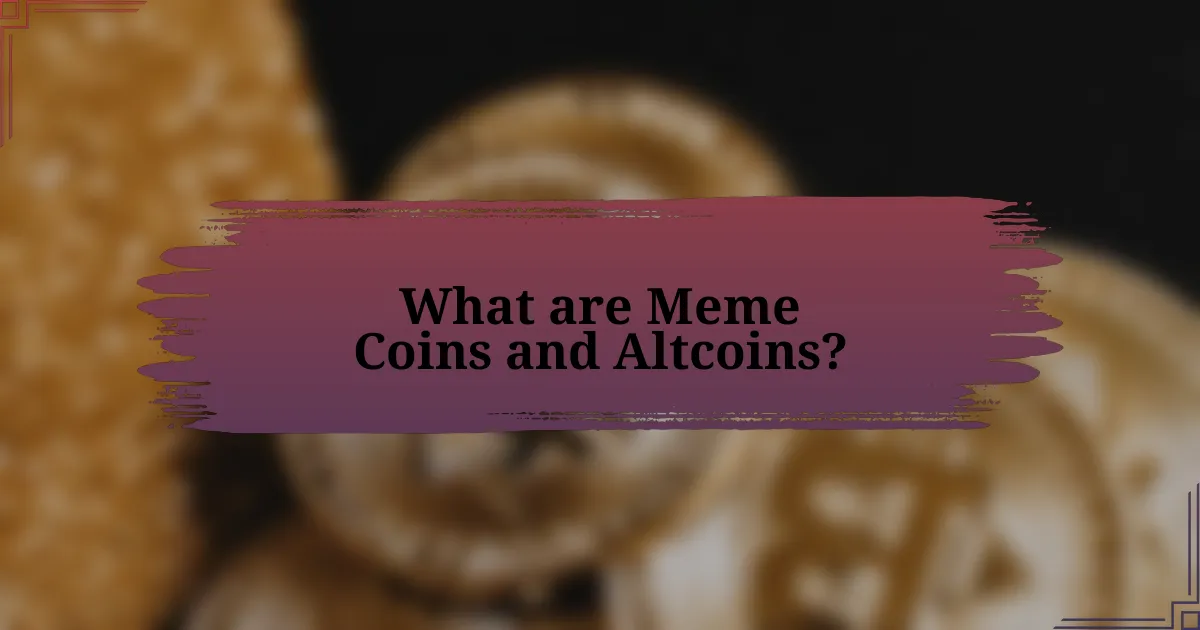
What are Meme Coins and Altcoins?
Meme coins are cryptocurrencies that gain popularity primarily through social media and internet memes, often lacking fundamental value or utility. Examples include Dogecoin and Shiba Inu, which were created as jokes but gained significant market traction due to community engagement and viral marketing.
Altcoins, on the other hand, refer to any cryptocurrency other than Bitcoin, encompassing a wide range of digital assets with various use cases, technologies, and purposes. Altcoins can include stablecoins, utility tokens, and security tokens, each designed to serve specific functions within their respective ecosystems.
The distinction between meme coins and altcoins lies in their purpose and market perception; while meme coins often rely on speculative trading and community hype, altcoins may offer technological advancements or real-world applications.
How do Meme Coins differ from Altcoins?
Meme coins differ from altcoins primarily in their purpose and community-driven nature. While altcoins are alternative cryptocurrencies to Bitcoin that often aim to solve specific problems or improve upon existing technologies, meme coins typically lack a serious utility and are created primarily for entertainment or as a joke, often gaining popularity through social media and community engagement. For example, Dogecoin, a well-known meme coin, started as a parody of Bitcoin but gained a massive following due to its community and viral marketing, contrasting with altcoins like Ethereum, which has a robust platform for decentralized applications.
What characteristics define Meme Coins?
Meme coins are characterized by their community-driven nature, often originating from internet memes or cultural references. These cryptocurrencies typically lack fundamental utility or technological innovation, relying instead on social media hype and community engagement for value appreciation. For example, Dogecoin, created as a joke in 2013, gained significant popularity due to its active online community and endorsements from celebrities. Additionally, meme coins often exhibit high volatility and speculative trading behavior, attracting investors looking for quick profits rather than long-term investment.
What characteristics define Altcoins?
Altcoins are defined by their characteristics of being alternative cryptocurrencies to Bitcoin, often featuring unique functionalities or use cases. These digital currencies can include variations in consensus mechanisms, such as proof of stake or delegated proof of stake, which differentiate them from Bitcoin’s proof of work. Additionally, many altcoins aim to solve specific problems or enhance blockchain technology, such as Ethereum’s smart contracts or Ripple’s focus on cross-border payments. The diversity in their purposes and technological frameworks contributes to their classification as altcoins, which collectively represent thousands of different cryptocurrencies in the market.
Why have Meme Coins gained popularity?
Meme coins have gained popularity primarily due to their viral nature and community-driven marketing. The rise of social media platforms, particularly Twitter and Reddit, has facilitated rapid dissemination of information and trends, allowing meme coins like Dogecoin and Shiba Inu to capture public interest quickly. Additionally, the speculative nature of cryptocurrency investments has attracted investors looking for high-risk, high-reward opportunities, further fueling the popularity of these coins. The phenomenon is evidenced by Dogecoin’s market capitalization reaching over $85 billion at its peak in May 2021, showcasing the significant financial backing and community support behind meme coins.
What role does social media play in the rise of Meme Coins?
Social media significantly accelerates the rise of Meme Coins by facilitating rapid information dissemination and community engagement. Platforms like Twitter, Reddit, and TikTok enable users to share memes, trading tips, and news, creating viral trends that attract new investors. For instance, the surge in popularity of Dogecoin was largely driven by social media campaigns and endorsements from influencers, which led to a dramatic increase in its market capitalization, reaching over $85 billion at its peak in May 2021. This illustrates how social media acts as a catalyst for the growth and popularity of Meme Coins, influencing investor behavior and market dynamics.
How do community engagement and memes influence investment?
Community engagement and memes significantly influence investment by creating a sense of belonging and driving interest in specific assets, particularly in the cryptocurrency market. Engaged communities often rally around memes that encapsulate their shared values or humor, which can lead to increased visibility and popularity of certain coins. For instance, the rise of Dogecoin was largely fueled by its meme culture and a strong community that actively promoted it on social media platforms, resulting in a market capitalization that peaked at over $85 billion in May 2021. This demonstrates how memes can transform a niche asset into a mainstream investment opportunity, attracting both retail and institutional investors.
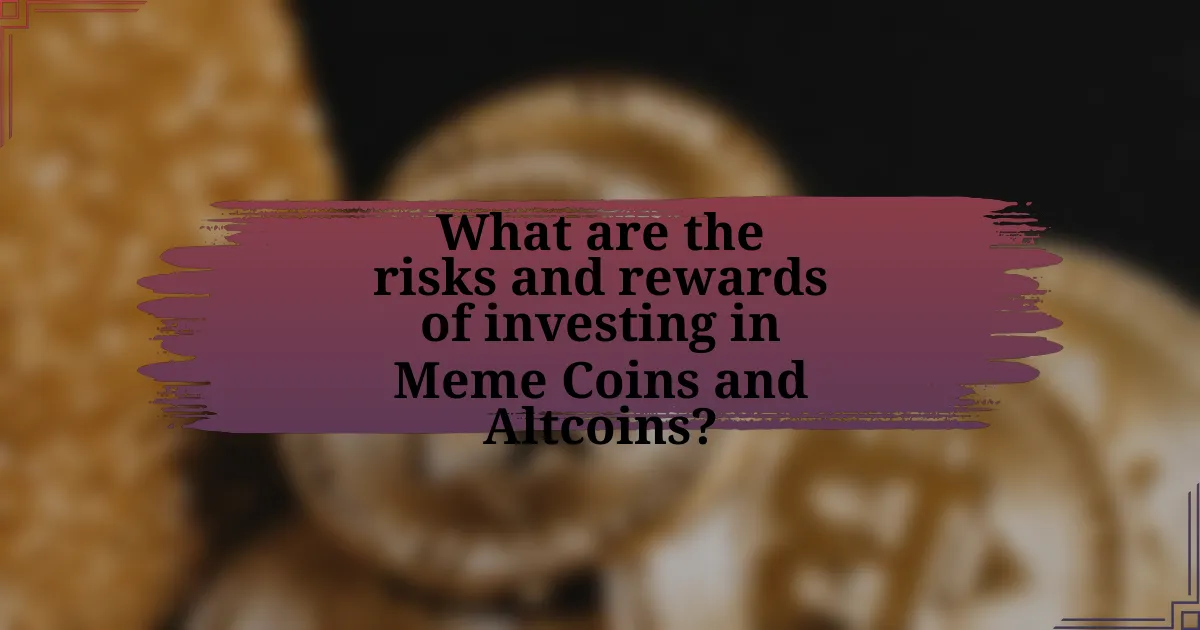
What are the risks and rewards of investing in Meme Coins and Altcoins?
Investing in Meme Coins and Altcoins carries significant risks and rewards. The primary risk involves high volatility, as these assets can experience drastic price fluctuations within short time frames, often driven by market sentiment and social media trends. For instance, the price of Dogecoin surged over 14,000% in 2021, showcasing potential rewards, but it also dropped significantly, highlighting the inherent risk.
Additionally, many Meme Coins and Altcoins lack fundamental backing or utility, making them susceptible to pump-and-dump schemes, where prices are artificially inflated before a sharp decline. Conversely, the rewards can include substantial returns on investment, as seen with early investors in Ethereum, which increased from under $1 in 2015 to over $4,000 in 2021.
In summary, while investing in Meme Coins and Altcoins can lead to high returns, it is accompanied by considerable risks due to market volatility and the potential for fraudulent activities.
What potential returns can investors expect from Meme Coins?
Investors can expect highly volatile returns from meme coins, with potential gains reaching several hundred to thousands of percent in short time frames. For instance, Dogecoin, initially created as a joke, surged over 12,000% in 2021, illustrating the extreme price fluctuations that can occur. However, these returns are accompanied by significant risks, as the market for meme coins is often driven by social media trends and speculative trading rather than fundamental value.
How do market trends affect the value of Meme Coins?
Market trends significantly influence the value of Meme Coins by driving investor sentiment and trading volume. When positive market trends emerge, such as increased interest in cryptocurrencies or favorable regulatory news, Meme Coins often experience price surges due to heightened demand and speculative trading. For instance, during the 2021 cryptocurrency bull market, coins like Dogecoin saw their values skyrocket, largely fueled by social media trends and celebrity endorsements, which are indicative of broader market enthusiasm. Conversely, negative market trends, such as market corrections or bearish sentiment, can lead to rapid declines in the value of Meme Coins, as investors may quickly sell off their holdings to mitigate losses. This volatility is further exacerbated by the speculative nature of Meme Coins, which are often driven more by trends and community engagement than by fundamental value.
What are the historical performance trends of Meme Coins?
Meme coins have exhibited significant volatility and speculative trading patterns historically. For instance, Dogecoin, one of the most prominent meme coins, saw a dramatic increase in value from approximately $0.002 in early 2021 to an all-time high of around $0.73 in May 2021, driven largely by social media trends and celebrity endorsements. Similarly, Shiba Inu experienced a meteoric rise, gaining over 1,000% in value within a few months in 2021, fueled by community engagement and hype. These trends indicate that meme coins often experience rapid price surges followed by steep declines, reflecting their speculative nature and reliance on market sentiment rather than fundamental value.
What are the risks associated with investing in Altcoins?
Investing in altcoins carries several risks, including high volatility, regulatory uncertainty, and potential for fraud. High volatility is evident as altcoins can experience significant price fluctuations within short periods, leading to substantial financial losses for investors. Regulatory uncertainty arises from the evolving legal landscape surrounding cryptocurrencies, which can impact the viability and legality of certain altcoins. Additionally, the potential for fraud is heightened in the altcoin market, where projects may lack transparency or be outright scams, as seen in numerous cases of failed projects or exit scams. These factors collectively contribute to the overall risk profile of investing in altcoins.
How do regulatory challenges impact Altcoin investments?
Regulatory challenges significantly impact Altcoin investments by creating uncertainty and risk for investors. When governments impose regulations or restrictions on cryptocurrencies, it can lead to price volatility, reduced market participation, and a lack of investor confidence. For instance, the SEC’s scrutiny of various Altcoins has resulted in legal actions that can diminish their market value and hinder their adoption. Additionally, regulatory clarity can enhance investor trust, as seen in jurisdictions that have established clear frameworks for cryptocurrency operations, leading to increased investment activity.
What are the common pitfalls investors face with Altcoins?
Investors commonly face several pitfalls with Altcoins, including lack of research, high volatility, and susceptibility to scams. Many investors do not conduct thorough due diligence on the projects behind Altcoins, leading to poor investment decisions. The cryptocurrency market is known for its extreme price fluctuations; for instance, according to CoinMarketCap, some Altcoins can experience price drops of over 90% within a short period. Additionally, the Altcoin space is rife with fraudulent schemes, as evidenced by the numerous cases of rug pulls and exit scams reported in the industry, highlighting the importance of verifying the legitimacy of projects before investing.
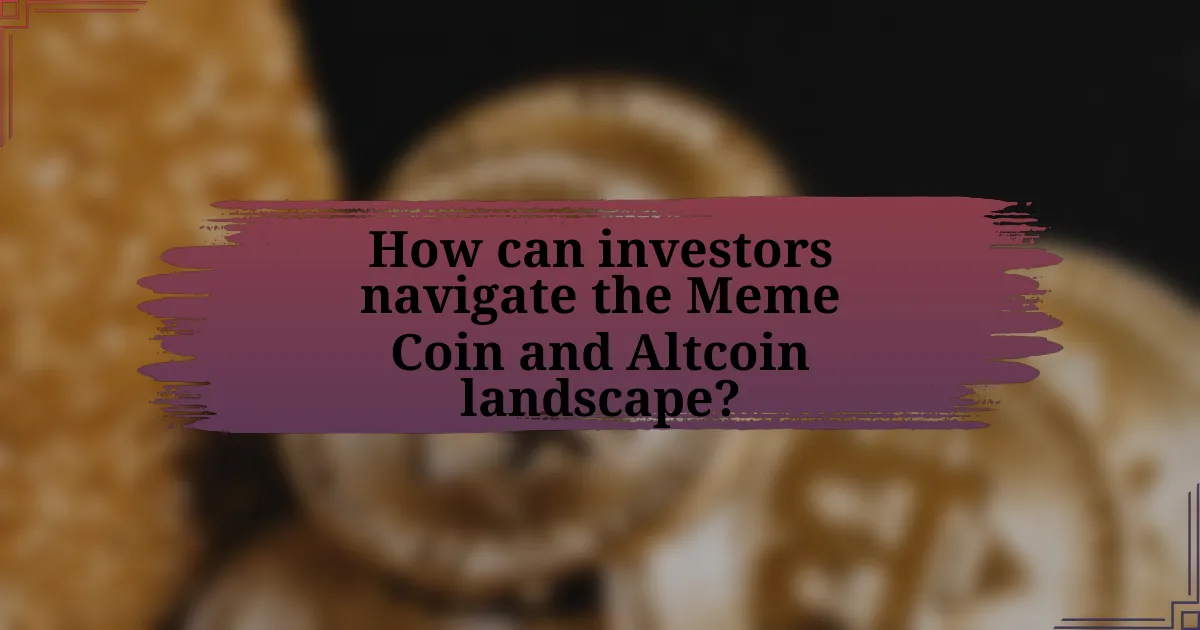
How can investors navigate the Meme Coin and Altcoin landscape?
Investors can navigate the Meme Coin and Altcoin landscape by conducting thorough research and analysis of each asset’s fundamentals, community support, and market trends. This involves evaluating the project’s whitepaper, understanding its use case, and assessing the team behind it. For instance, successful Meme Coins like Dogecoin gained traction due to strong community engagement and social media presence, while Altcoins such as Ethereum are backed by robust technology and real-world applications. Historical data shows that investors who prioritize due diligence and stay informed about market sentiment are more likely to make sound investment decisions in this volatile space.
What strategies should investors consider when investing in Meme Coins?
Investors should consider conducting thorough research and analysis before investing in Meme Coins. This includes evaluating the project’s community engagement, market trends, and the credibility of the development team. For instance, the success of Dogecoin, a prominent Meme Coin, was largely driven by its strong community support and social media presence, which can significantly influence price movements. Additionally, investors should be cautious of the high volatility associated with Meme Coins, as they can experience rapid price fluctuations. Historical data shows that many Meme Coins have seen dramatic rises and falls, underscoring the importance of risk management strategies, such as setting stop-loss orders and diversifying investments.
How can investors assess the credibility of a Meme Coin?
Investors can assess the credibility of a Meme Coin by evaluating its community engagement, development team transparency, and market performance. A strong community presence on platforms like Reddit or Twitter indicates active support and interest, which can enhance credibility. Transparency from the development team, such as clear communication and a well-defined roadmap, is crucial; projects with anonymous teams often raise red flags. Additionally, analyzing market performance metrics, including trading volume and price stability, can provide insights into the coin’s legitimacy. For instance, a Meme Coin that has consistently maintained a market cap and trading volume over time is generally viewed as more credible than one with erratic fluctuations.
What indicators should investors look for in Meme Coin projects?
Investors should look for community engagement, market capitalization, and developer activity in Meme Coin projects. Community engagement is crucial as a strong, active community often drives the popularity and adoption of a meme coin, evidenced by platforms like Reddit and Twitter where discussions and promotions occur. Market capitalization provides insight into the coin’s overall value and stability; a higher market cap typically indicates a more established project. Developer activity, measured through GitHub contributions or updates, reflects the project’s ongoing development and potential for future growth, as seen in successful meme coins that have maintained consistent updates and community interaction.
What best practices should be followed for Altcoin investments?
Best practices for Altcoin investments include conducting thorough research, diversifying your portfolio, and setting clear investment goals. Conducting thorough research involves analyzing the project’s whitepaper, team, technology, and market potential, which helps in making informed decisions. Diversifying your portfolio reduces risk by spreading investments across multiple altcoins rather than concentrating on a single asset. Setting clear investment goals, such as defining your risk tolerance and expected returns, guides your investment strategy and helps in maintaining discipline. These practices are essential for navigating the volatile nature of the altcoin market, where informed decisions can significantly impact investment outcomes.
How can diversification mitigate risks in Altcoin portfolios?
Diversification can mitigate risks in Altcoin portfolios by spreading investments across various cryptocurrencies, which reduces the impact of poor performance from any single asset. When an investor diversifies their Altcoin holdings, they lower the likelihood of significant losses because different Altcoins often react differently to market conditions. For instance, during market downturns, some Altcoins may retain value or even appreciate, while others may decline sharply. Historical data shows that portfolios with a mix of assets tend to have lower volatility and higher risk-adjusted returns compared to concentrated portfolios. This strategy is supported by the Modern Portfolio Theory, which emphasizes that a diversified portfolio can achieve optimal returns for a given level of risk.
What resources are available for researching Altcoins?
To research Altcoins, several resources are available, including cryptocurrency exchanges, market analysis platforms, and dedicated cryptocurrency news websites. Cryptocurrency exchanges like Binance and Coinbase provide real-time data on Altcoin prices and trading volumes, which are essential for understanding market trends. Market analysis platforms such as CoinMarketCap and CoinGecko offer comprehensive data on Altcoin performance, including historical price charts and market capitalization. Additionally, cryptocurrency news websites like CoinDesk and The Block deliver the latest news and insights, helping investors stay informed about developments in the Altcoin space. These resources collectively provide a robust foundation for researching and analyzing Altcoins effectively.
What practical tips can enhance investment success in Meme Coins and Altcoins?
To enhance investment success in Meme Coins and Altcoins, investors should conduct thorough research on the projects, including their use cases, community engagement, and development team credibility. This approach is supported by the fact that successful investments often stem from understanding the fundamentals of the asset, as evidenced by the rise of projects like Dogecoin and Shiba Inu, which gained traction due to strong community support and clear use cases. Additionally, diversifying investments across multiple coins can mitigate risks, as seen in the volatility of the cryptocurrency market, where individual coins can experience significant price fluctuations. Lastly, setting clear investment goals and adhering to a disciplined strategy can help investors navigate the emotional challenges of trading in these highly speculative assets.

